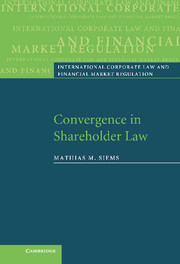Book contents
- Frontmatter
- Contents
- Preface and acknowledgments
- List of abbreviations
- Table of cases
- Table of legislation
- Introduction
- PART I The object and course of the investigation
- PART II The status quo of convergence
- PART III Developmental trends and patterns
- PART IV Conclusion
- 12 Convergence as a model for the future
- 13 Summary of principal findings
- References
- Index
12 - Convergence as a model for the future
Published online by Cambridge University Press: 15 December 2009
- Frontmatter
- Contents
- Preface and acknowledgments
- List of abbreviations
- Table of cases
- Table of legislation
- Introduction
- PART I The object and course of the investigation
- PART II The status quo of convergence
- PART III Developmental trends and patterns
- PART IV Conclusion
- 12 Convergence as a model for the future
- 13 Summary of principal findings
- References
- Index
Summary
At the legal-policy level, the first question arising is the proper level and form of regulation. No simple solution is to be expected here, since, for instance, when considering the variants of centralized v. decentralized or governmental v. private law-making, costs and benefits have to be weighed up in each case. Thus, it has first to be clarified whether international and regional law ought to contribute even more than hitherto to a ‘convergence from above’ (section I below). Secondly, in cases of ‘convergence from below’, closer study should consider whether for instance regulatory competition, the use of self-regulation and a ‘convergence principle’ in case law ought to operate to bring the legal systems closer together (section II below). Finally, the issues of the substantive orientation of shareholder law will be looked at again (section III below).
Convergence ‘from above’
International or regional organizations can act upon law ‘from above’ by themselves laying down uniform provisions (subsection 1 below). Since this sort of comprehensive unification of law is, however, open to objections and politically hard to achieve, it may in future be mainly other regulatory models that promise success (subsection 2 below).
Reasons for unification of law
There are a number of reasons which can be adduced for a unification of law. Furthermore, a distinction has to be drawn here between arguments for uniform law as such and unification through international and regional law.
- Type
- Chapter
- Information
- Convergence in Shareholder Law , pp. 373 - 395Publisher: Cambridge University PressPrint publication year: 2007

